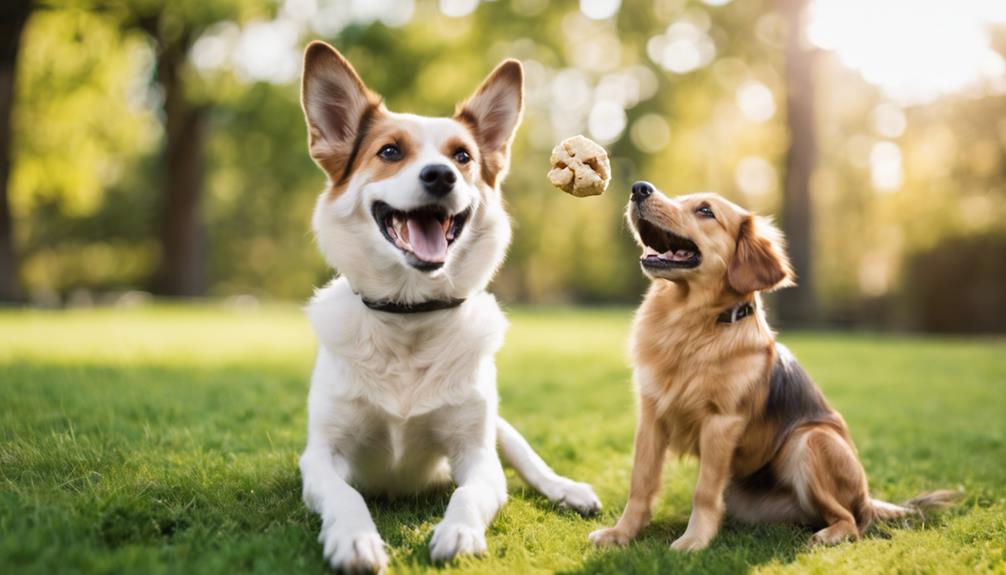Mastering Canine Psychology for Improved Communication
You might think that understanding canine psychology is complex, but it's more intuitive than you realize.
By grasping the basics of how dogs think and communicate, you can unlock a whole new level of connection with your furry companion.
Imagine being able to anticipate your dog's needs before they even bark, and respond in a way that strengthens your bond.
There's a fascinating world waiting to be explored when you dive into the intricacies of canine psychology.
Understanding Canine Body Language
To better understand your dog's emotions and intentions, pay close attention to their body language. Dogs communicate primarily through nonverbal cues, making it essential for you to be observant. One key body language cue to look for is tail wagging. Contrary to popular belief, a wagging tail doesn't always signify happiness. The speed and height of the wag can indicate different emotions, such as excitement, nervousness, or aggression. Similarly, a relaxed body posture with a wagging tail can signal friendliness, while a tense body and a stiff tail may indicate discomfort or fear.
Eyes are another important indicator of your dog's state of mind. Direct eye contact can be perceived as a challenge in the canine world, while averted eyes may signal submission or fear. Additionally, the position of the ears can provide insights into your dog's mood. Forward-facing ears often indicate alertness or curiosity, while flattened ears suggest anxiety or submissiveness.
The Role of Pack Mentality
When considering your dog's behavior, understanding the role of pack mentality is crucial for effective communication. Dogs are pack animals, and pack dynamics play a significant role in their behavior.
Within a pack, there's a hierarchy based on dominance, with one or more alpha dogs leading the group. This alpha behavior is often displayed through confident body language, assertive actions, and maintaining control over valuable resources like food and toys.
Understanding pack hierarchy is essential because your dog sees your family as their pack, and they look to you as the leader.
Building Trust With Your Dog
Building trust with your dog starts by consistently demonstrating reliability and establishing a safe environment for them to thrive in. Bonding exercises are a great way to strengthen your relationship and trust with your furry companion. Activities like going for walks, playing interactive games, or even just spending quality time together can help build a strong bond. Trust building activities, such as positive reinforcement training, where you reward good behavior, also play a crucial role in establishing trust.
Consistency is key when it comes to building trust with your dog. By being reliable in your actions and reactions, your dog will learn to trust you more. Remember to always provide a safe and secure environment for your dog, where they feel comfortable and protected. Through bonding exercises and trust building activities, you can create a strong foundation of trust that will enhance communication and strengthen your relationship with your dog.
Establishing Leadership and Boundaries
Establishing a clear hierarchy within your canine-human relationship is essential to set boundaries and provide direction for your dog. As a dog owner, your leadership presence plays a vital role in creating a harmonious relationship with your furry companion.
Here's how you can effectively establish leadership and boundaries:
- Consistent Discipline: Implementing consistent rules and consequences helps your dog understand what's expected of them.
- Assertive Guidance: Use assertive yet gentle guidance to communicate your expectations clearly to your dog.
- Setting Boundaries: Clearly define boundaries and ensure they're consistently enforced to prevent confusion.
- Leading by Example: Be a role model for your dog by displaying behaviors you want them to emulate.
Canine Communication Signals
To effectively understand and interpret your dog's needs, pay close attention to their various canine communication signals. Dogs communicate through a combination of vocalizations and postures. Understanding their vocalizations, such as barks, whines, and growls, can give you insight into their emotions and desires. For example, a high-pitched bark may indicate excitement, while a low growl can signal aggression or discomfort.
Additionally, observing your dog's body language and postures is crucial for interpreting their feelings. Recognizing stress signals like panting, pacing, or a tucked tail can help you address situations that may be causing anxiety for your furry friend. On the other hand, relaxation signals such as a loose body posture, wagging tail, or exposed belly indicate that your dog is feeling comfortable and at ease.
Handling Fear and Anxiety in Dogs
When your dog exhibits signs of fear and anxiety, it's essential to respond calmly and provide reassurance to help them feel safe and secure. Dogs, like humans, can experience a range of anxieties that may manifest in various behaviors.
To address these issues effectively, consider the following:
- Calming Techniques: Implement calming techniques such as gentle petting, soothing verbal cues, or creating a quiet and safe space for your dog to retreat to.
- Behavior Modification: Work with a professional trainer or behaviorist to develop a behavior modification plan tailored to your dog's specific fears and anxieties.
- Consistent Routine: Establish a consistent daily routine to provide your dog with a sense of predictability and stability, which can help reduce feelings of anxiety.
- Positive Reinforcement: Use positive reinforcement techniques to reward calm and confident behaviors, reinforcing the desired responses in fearful situations.
Positive Reinforcement Training Techniques

For effective positive reinforcement training techniques, focus on rewarding desired behaviors in your dog consistently. By using motivational rewards such as treats, praise, or playtime, you can encourage good behavior and facilitate behavior modification in your canine companion. When your dog displays the desired behavior, immediately reward them to reinforce the connection between the action and the positive outcome. This will help your dog understand what behavior is being rewarded and increase the likelihood of them repeating it in the future.
Consistency is key in positive reinforcement training. Make sure to reward your dog every time they exhibit the desired behavior to create a strong association between the action and the reward. This consistency will help your dog learn more effectively and accelerate the behavior modification process. Additionally, keep training sessions short and engaging to maintain your dog's interest and motivation.
Enhancing Canine-Human Bond
Strengthen your bond with your canine companion by engaging in activities that promote mutual understanding and trust. By focusing on bonding activities and communication exercises, you can deepen your connection with your furry friend.
Here are some ways to enhance the canine-human bond:
- Daily Walks: Take your dog for regular walks in different environments to explore together and build trust.
- Training Sessions: Engage in interactive training sessions to improve communication and strengthen the bond between you and your pet.
- Playtime: Incorporate interactive play sessions into your daily routine to have fun and strengthen the emotional connection.
- Quality Time: Set aside dedicated time each day to spend with your dog, whether it's cuddling on the couch or enjoying a relaxing grooming session.
Frequently Asked Questions
How Can I Effectively Handle a Dog Who Becomes Aggressive Towards Other Animals or People?
When your dog becomes aggressive towards other animals or people, behavior modification techniques like desensitization can help.
Start by gradually exposing your dog to the trigger in a controlled environment. Use positive reinforcement and counter conditioning to change your dog's response to the situation.
Reward calm behavior and seek professional help if needed. Consistency and patience are key in addressing aggression issues in your canine companion.
Is It Possible for a Dog to Exhibit Dominant Behavior Without It Being a Sign of a Larger Issue?
Yes, it's possible for a dog to display dominant behavior without it indicating a bigger problem. Consistent training and clear boundaries help address such behaviors.
Understanding dog communication cues can aid in managing dominance issues effectively. By establishing yourself as the pack leader through positive reinforcement and structured training, you can help your dog learn appropriate behavior and build a stronger bond based on respect and trust.
What Are Some Common Mistakes That Dog Owners Make When Trying to Establish Leadership With Their Pets?
When trying to establish leadership with your pet, common mistakes include inconsistency in obedience training, lacking understanding of pack hierarchy, and neglecting proper socialization techniques.
These errors can lead to confusion in your dog, hindering behavior modification efforts. It's essential to be firm yet gentle, establish clear boundaries, and provide positive reinforcement for desired behaviors.
How Can I Address Separation Anxiety in My Dog and Help Them Feel More Secure When I Am Not Around?
To help your dog with separation anxiety, use positive reinforcement and desensitization techniques.
Start by creating a routine, building trust through consistent interactions. Leave gradually for short periods, rewarding calm behavior.
Provide engaging toys or treats when you're away. Practice short departures to help your dog feel more secure.
Are There Any Specific Techniques or Strategies for Managing a Dog's Fear of Loud Noises or Unfamiliar Situations?
When your dog is scared of loud noises or new situations, try desensitization training and counterconditioning techniques.
Gradually expose them to the scary things in a controlled way to build up their tolerance. Make safe spaces available for them to retreat to when overwhelmed.
Consider using calming aids like pheromone diffusers or anxiety wraps to help ease their stress. Consistency and patience are key in helping your dog feel more comfortable and secure.
Conclusion
By mastering canine psychology, you can improve communication with your furry friend. Understanding their body language, pack mentality, and communication signals will help you build trust and establish leadership.
Using positive reinforcement training techniques will enhance your bond and help you handle fear and anxiety in dogs. Remember, consistency and patience are key in becoming a confident and effective dog owner.
So keep practicing and enjoy the rewards of a strong relationship with your canine companion.
